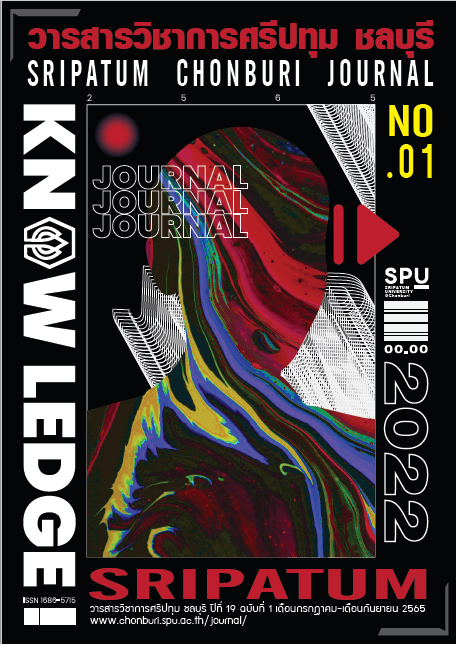A STUDY OF THE INFLUENCE OF THE TOURISM IMAGE ON THE TOURISM DEMAND FOR THE END ZONE OF A SECONDARY CITY ON THE EAST COAST
Keywords:
Secondary city, Tourism image, Tourism demandAbstract
The objectives of the research were to study the relationship of the tourism image and tourism demand for the end zone of secondary cities on the east coast of Thailand and the influence of the tourism image on the tourism demand for those cities. The sampled consisted of 400 Thai tourists, 10 of which were selected for an interview. The research instruments consisted of a semi-structured interview form and an opinion questionnaire. The research instruments were quality checked with S-CVI/Ave = .90 by Cronbach's alpha coefficient that was .97. The data analysis included correlation coefficient analysis, regression analysis, and content analysis.
The research results showed that the tourism image and tourism demand for the end zone of secondary cities on the east coast had a positive correlation. The tourism image had an influence on the tourism demand for those cities. Therefore, tourism in the end zone of those cities should mainly maintain and conserve the image of physical, cultural, and historical tourism. Simultaneously, the image of the architecture, flora and fauna, and economics should also be maintained so that such things could be developed, respectively.
References
การท่องเที่ยวแห่งประเทศไทย. (2561). “ททท. งัด 7 คัมภีร์ Go Local บุกครึ่งหลังปี 61 ต่อยอด 4 เดือนแรก 55 เมืองรองโกย 8 หมื่นล้าน” (ออนไลน์). เข้าถึงได้จาก:
https://www.matichon.co.th/publicize/news_1018615 [2563, 17 เมษายน].
ชลดา แสนคำเรือง และกิตติพันธ์ คงสวัสดิ์เกียรติ. (2556). ปัจจัยที่มีผลต่ออุปสงค์การท่องเที่ยว: กรณีศึกษา การท่องเที่ยว ในจังหวัดเลย. วารสารการเงิน การลงทุน
และการบริหารธุรกิจ, 3(4), หน้า 223-242.
ณัฐพงศ์ วิชัยดิษฐ์ และผกามาศ ชัยรัตน์. (2563). ภาพลักษณ์การท่องเที่ยวที่ส่งผลต่อการตัดสินใจเดินทางท่องเที่ยวของนักท่องเที่ยวในอุทยานประวัติศาสตร์
พระนครศรีอยุธยา. วารสารวิทยาลัยสงฆ์นครลำปาง, 9(2), หน้า 183-192.
บุญเลิศ จิตตั้งวัฒนา และเพ็ญศิริ ศรีคำภา. (2548). การพัฒนาการท่องเที่ยวแบบยั่งยืน. กรุงเทพฯ: มหาวิทยาลัยธรรมศาสตร์.
ประเสริฐ ใจสม, ศรีปริญญา ธูปกระจ่าง, ชาญเดช เจริญวิริยะกุล, ปฎิญญา บุญผดุง และเอื้ออัมพร ทิพยทิฆัมพร. (2563). บุพปัจจัยของความยั่งยืนของการท่องเที่ยว
เมืองรอง. วารสารสันติศึกษาปริทรรศน์ มจร, 8(1), หน้า 133-144.
พิริยะ ผลพิรุฬห์. (2553). เศรษฐศาสตร์ภาคบริการ. กรุงเทพฯ: สำนักงานกิจการโรงพิมพ์องค์การสงเคราะห์ทหารผ่านศึก.
สุวัตร สิทธิหล่อ. (2558). ท่องเที่ยวไทยก้าวไกลอาเซียน. วารสารบริหารธุรกิจ เศรษฐศาสตร์และการสื่อสาร, 10(2), หน้า 1-4.
Burns, Peter. M., & Novelli, Marina. (2008). Tourism development: growth, myths, and inequalities. London, UK: CABI.
Ching-Fu, Chen, & DungChun, Tsai. (2007). “How destination image and evaluative factors affect behavioral intentions?”. Tourism
Management, 28(4), pp. 1115-1122.
Yamane, Taro. (1973). Statistics: An introductory analysis (3rd ed). New York, NY: Harper and Row.
Downloads
Published
Issue
Section
License

This work is licensed under a Creative Commons Attribution-NonCommercial-NoDerivatives 4.0 International License.
บทความทุกบทความเป็นลิขสิทธิ์ของวารสารวิชาการศรีปทุม ชลบุรี



